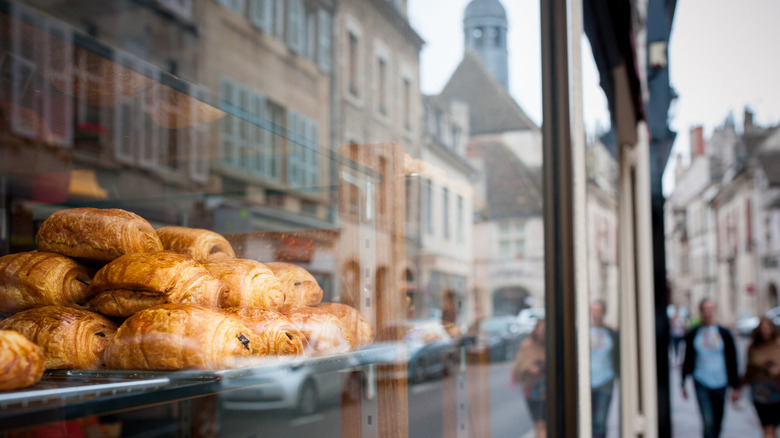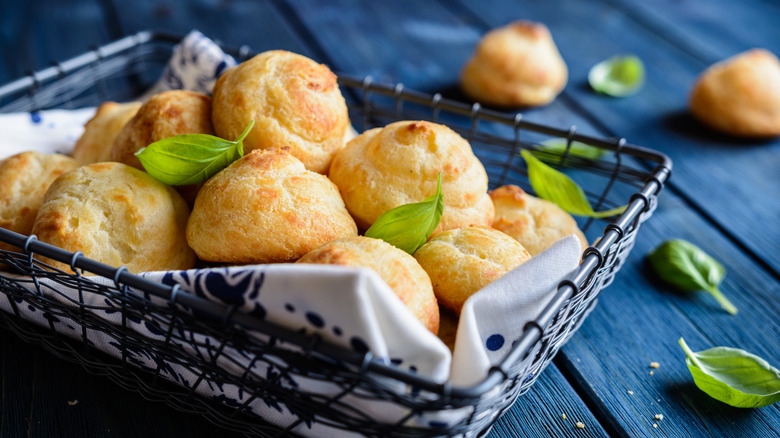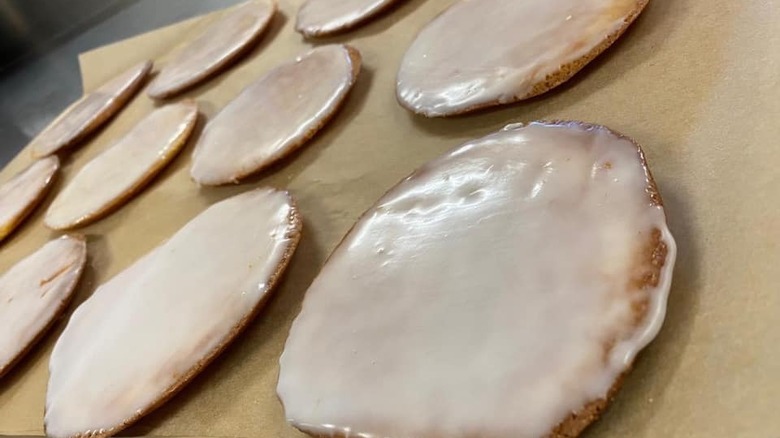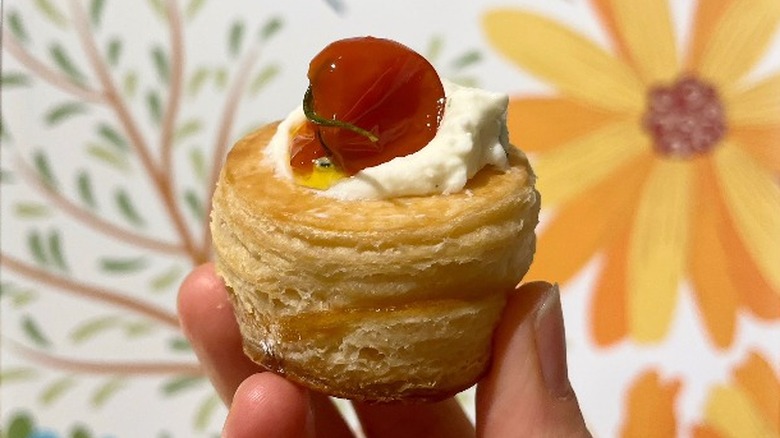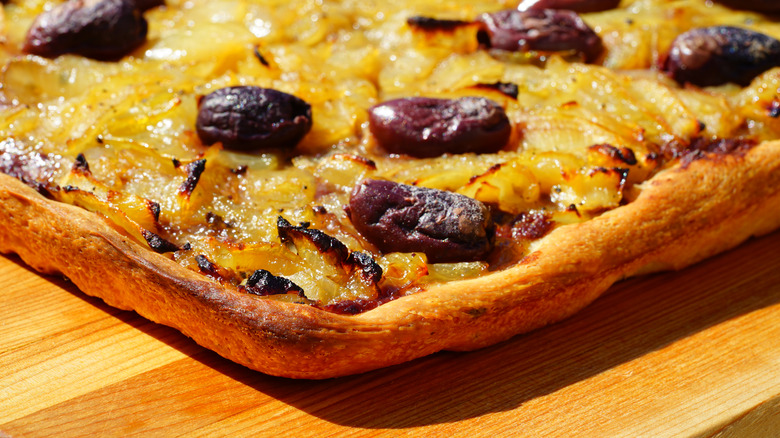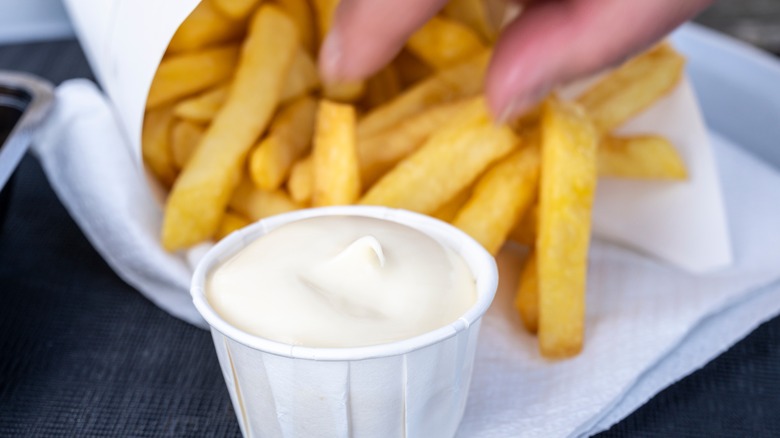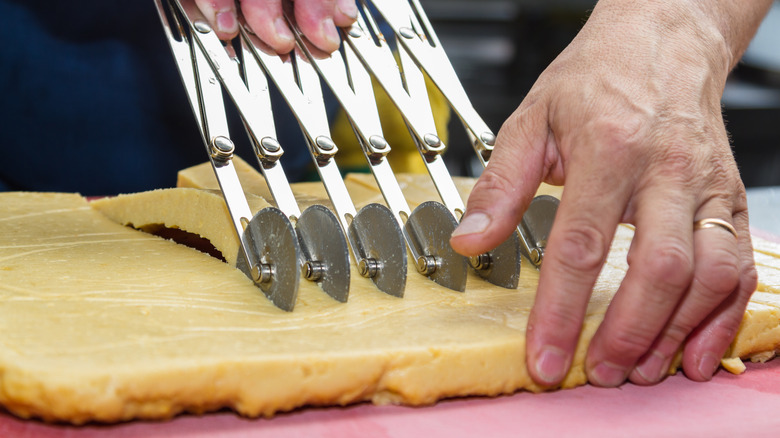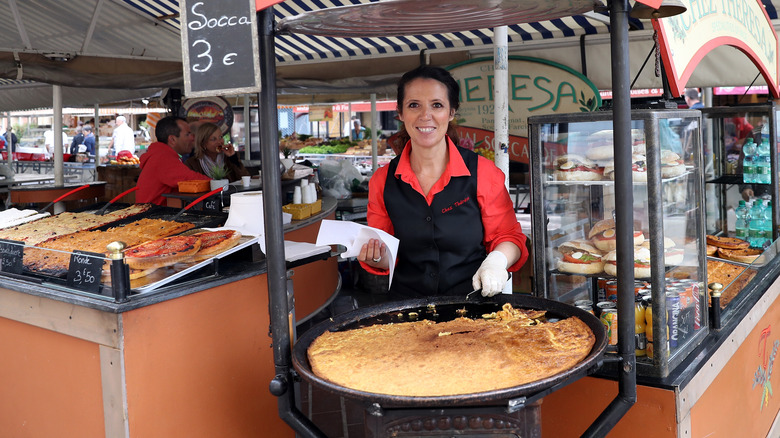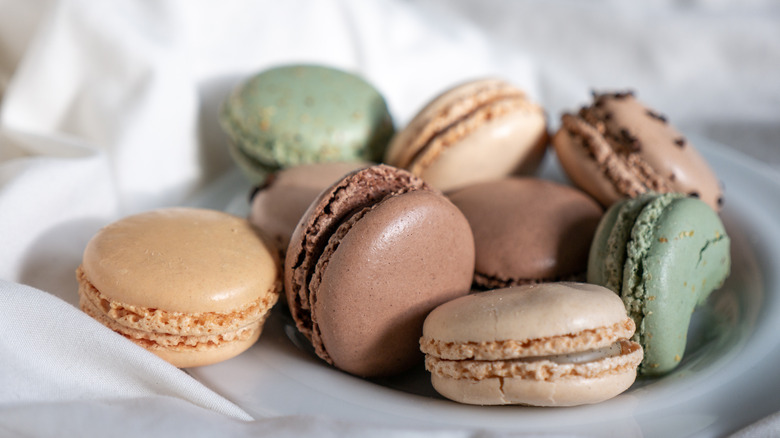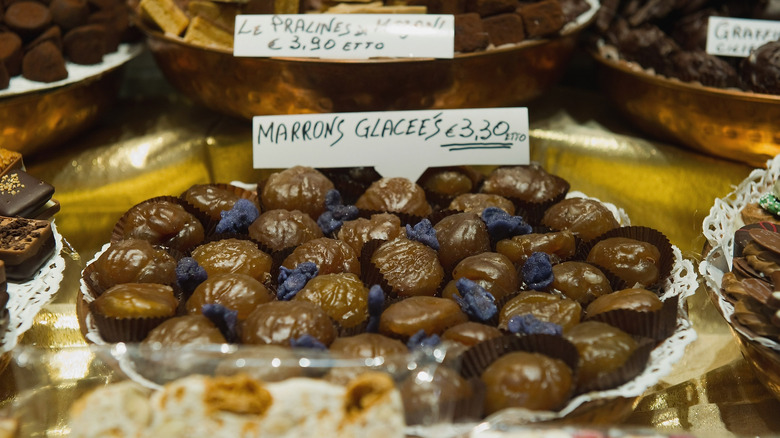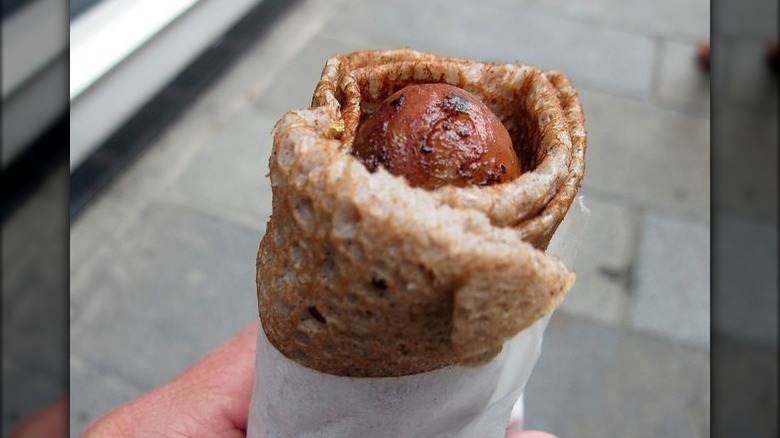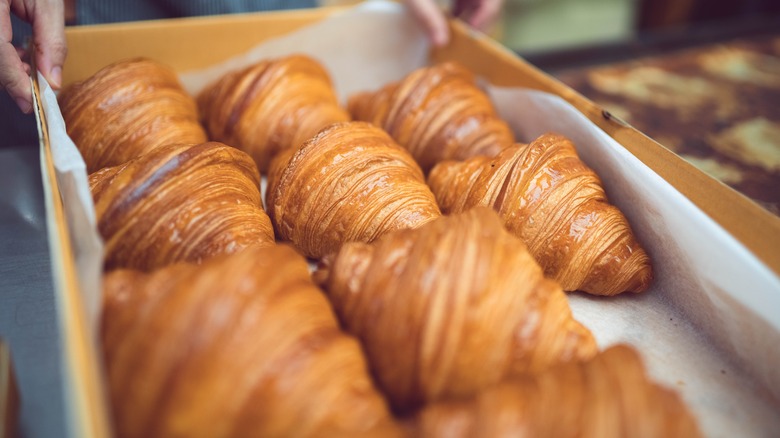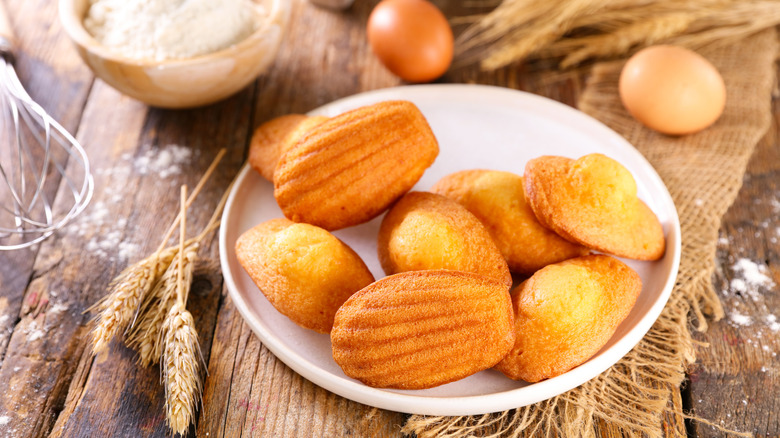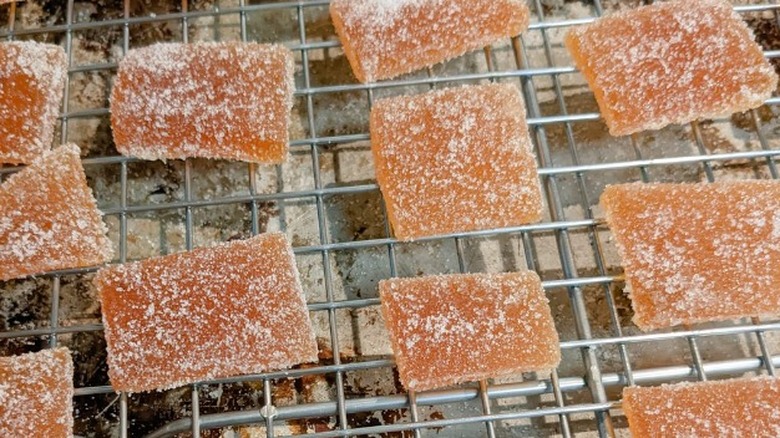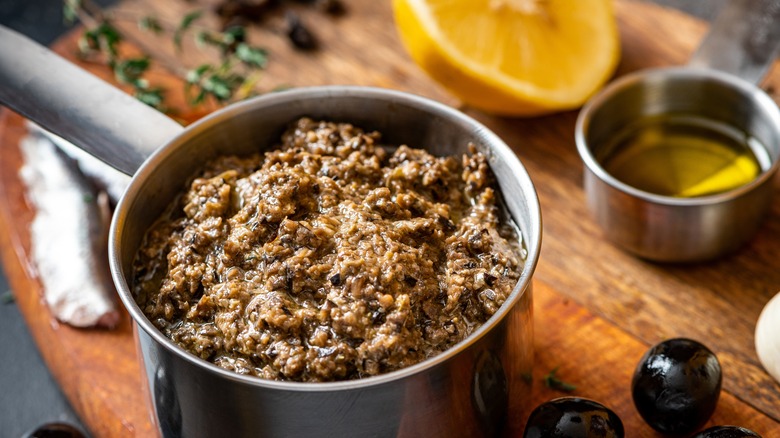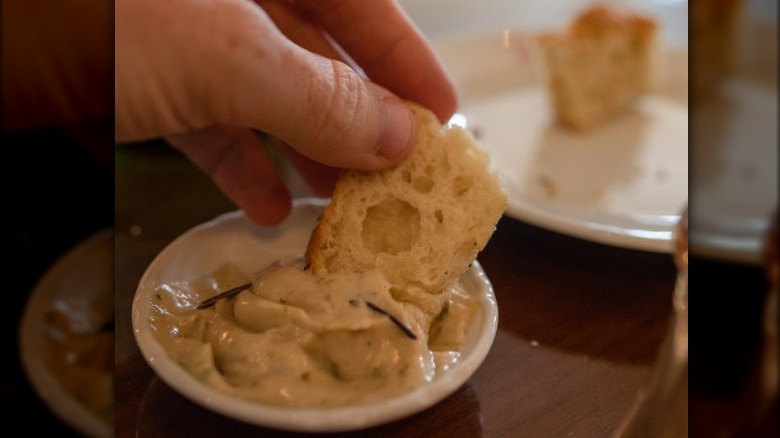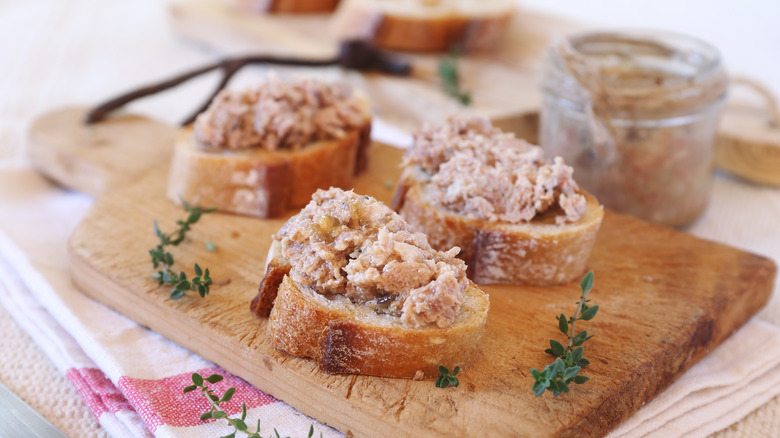16 Essential French Snack Foods You Need To Try
Think fine dining. Think "fancy" food. Think some of the greatest food cultures in the world. You're likely thinking of the French and French cuisine. For centuries, France has been known for its food culture, setting the standards by which other countries' cuisines were often measured. French cooking methods are an important part of culinary training. Travelers headed to France often reference the food as one of the things they most look forward to. In 2010, as The Guardian reports, UNESCO even honored French gastronomy by adding it to the Representative List of the Intangible Cultural Heritage of Humanity.
But for all the French fine dining and fancy meals in restaurants with white tablecloths, the country still has its snack foods. Of course, most French snack foods are a little fancier than, say, spray cheese from a can on crackers or toaster pastries — though there's certainly nothing wrong with either. Who hasn't craved delicious Easy Cheese or Pop-Tarts? Still, when you're in the mood for a snack that's a bit of an upgrade, you'd do well to consider one of these 16 essential French snack foods that you need to try.
1. Gougères
Cheese? Good. Bread? Also good. Cheese in bread? Even better. The gougère is the French version of a cheese puff (via France Today). The savory treats are made with choux pastry, which, if you've watched your fair share of "The Great British Bake Off," you know is a basic French pastry dough made from a mixture of flour, water or milk, eggs, and butter, combined and heated on the stovetop before baking. The result is a light, airy pastry perfect for filling, which is why it's also used to make éclairs in addition to the gougères (though cheese is added to the mix when making gougeres).
The Burgundy region of France claims gougères as its own invention, stating that a baker there invented the snack in the early 1800s. The village of Flogny-la-Chapelle hosts a gougères festival each year and, now, you can find these little cheesy balls served in bakeries and as appetizers.
2. Palets de dames
The name "palets de dames" means "ladies' pucks" and these cookies, if made correctly, look a little like a parasol, with a wide circular top and rounded bottom, according to The Forward and the Leo Baeck Institute. Originating near the French-Belgium border, the cookies can be made a variety of ways, with a variety of toppings. Sometimes, they're made with rum and currants. Sometimes they're topped with sanding sugar, pralines, or marmalade. The cookies, with their cake-like texture, however, are always topped with icing. Similarly, sometimes, the cookies are made in various sizes, but always in a circle.
If you've made madeleines — or even if you haven't — palets de dames is a relatively easy cookie and French snack food to bake, with the recipe being relatively forgiving, especially compared to some of the more pastry-focused French snack foods one could make. Paired with a cup of coffee, the palets de dames are a delicious snack any time of day.
3. Vol-au-vent
Put very, very simply, the vol-au-vent, as Oxford Reference defines, is just a filled puff pastry. The puff pastry filling is usually savory, with an accompanying sauce, and the vol-au-vent might be served either hot or chilled. For anyone who's ever eaten or made vol-au-vent before, however, you know that this tasty little bite is more complex than meets the eye.
Vol-au-vent is nothing new. Frederick Vine was writing about the French snack in his book "Savoury Pastry: Savoury Dish and Raised Pies, Pork Pies, Patties, Vol-au-vents, Mincemeats and Pies, and Miscellaneous Savoury Pastries," published in 1900. In the book, Vine notes that making a vol-au-vent requires patience and ingenuity and that the fillings can be quite expensive. His recipes call for fillings made from lobster, oysters, mushrooms, sweetbreads, and truffles, among other ingredients. However, you can enjoy a taste of this French classic at a relatively low cost and with as little work as popping something in the microwave and spooning it into premade pastry shells. You can now buy frozen vol-au-vent filling, like this option from Plaisirs Gastronomiques, which is filled with vegetables and chicken. Think of it as a smaller, more snack-ready chicken pot pie.
4. Pissaladière
We have the good people of Nice, France, to thank for the pissaladière (via Saveur). This tart is, in many ways, like a very much upgraded pizza. The original method of making pissaladière requires that you mix some sardines and anchovies with salt and spices before allowing the pungent combo to ferment for more than a month, after which you would press the fermented mix through a sieve and bake it on top of bread dough. However, you can skip this bit if you don't have 45 days or just don't care all that much for fermented fish.
The savory, salty dish, enjoyed in slices is more commonly today made with onions, olives, and whole anchovies. No salt, spices, sieve, or pressing is required. The dish is a popular street food and can be enjoyed both as a snack (maybe to soak up all that French wine?) or as part of a larger meal.
5. Pommes frites
If any French snack on this list is going to be familiar, it's going to be pommes frites, aka french fries. But we know what you've heard — Aren't french fries actually Belgian?
Well, that's still a story that's up for debate. As the New York Post reported, the French and the Belgians are hesitant at best to give up credit for this invention. The French say that fries hail from Paris. One French food historian claimed that today's fries can be traced back to the late 1700s, when food cart vendors would serve deep-fried potatoes to theater patrons, establishing their spot in the diets of Parisian artists and entertainers. Along these lines, the French newspaper Le Figaro reported that French publications in the 1860s talked about "fried potatoes" in print, and fry recipes — notably set apart by their sliced shape, so different from your standard home-fry-style fried potatoes — found their way into French cookbooks around the same time.
Wherever they came from, though, one thing is clear. French fries are delicious and there's hardly any better snack when you're craving something salty.
6. Panisses
The French have salty, fried snacks beyond the french fry — such as panisses, which Saveur even calls a french fry replacement. Panisses are very similar to french fries, but made from chickpeas. Originating in Provence and, more specifically, Marseille, this street food is as simple as it gets. Chickpea flour and water are combined and cooked together. The resulting paste is formed into fry-like shapes (if you're in Marseille; elsewhere, you might find them shaped differently), and then fried in oil and butter. Then the panisses can be seasoned before being served in a paper cone, much like french fries.
However, just because panisses are eaten like french fries, cooked like french fries, and served like french fries, it's important to note that they're not entirely the same, flavor or texture-wise. The chickpea flour makes for a creamy interior that's likened to polenta, despite the crispy exterior. Additionally, sometimes panisses are served sweet rather than savory, with sugar on top, especially when given to children.
7. Socca
Socca is a Nice-derived snack that, like the panisse, also requires chickpea flour. However, the two are markedly different. Saveur notes that socca is baked rather than fried. The Culture Trip likens socca more to a pancake than a french fry, which is the closest thing you might have experienced to a panisse. For all their differences, though, socca does have a few things in common with panisses. Socca is also a street food served in paper or napkins and enjoyed alongside a glass of wine.
The stories behind socca's invention differ. Some say that Romans traveling through Nice would mix together chickpea flour and water to create a batter and then would fry that mixture in pancake form atop their shields, which they would use as makeshift griddles over open fires. Others claim that Nice locals created socca during times of war, as chickpea flour and olive oil, necessary ingredients for the snack food, were plentiful.
8. Macarons
Maybe behind french fries, macarons are the second-most well-known snack food of France. These adorable little light and airy sandwiches with a tasty filling are an elegant treat and, if you're lucky enough to know how to make macarons from scratch, you'll be among the few talented home bakers who can do so.
But where did these little cakes that are so synonymous with French pâtisserie come from? According to The Culture Trip, macarons go way, way back, all the way to the Middle Ages and even further, when the pastries were still made with the requisite almonds, egg whites, and sugar. It's estimated that people were making macarons as early as 700 A.D., though in Italy, rather than in France. Catherine de' Medici is reputed to have introduced the sweet treat to the French in the 16th century. Fun fact: the Italians called macarons "priests' bellybuttons." The French macaron really didn't kick off until the French Revolution, in Nancy, France.
9. Marrons glacés
The French can't claim marrons glacés all for themselves. Italy has a stake in the sweet snack food, too. However, despite this shared heritage, marrons glacés, aka candied chestnuts, are still worth a taste if you've never tried them. The candied chestnuts are often sold individually in near bite-size servings, and aren't on the budget-friendly side, as Smithsonian Magazine describes, but the nutty flavor and super-sugary exterior make for a one-of-a-kind, can't-miss experience.
Gamberro Rosso International says that marrons glacés first showed up in France around the 1500s, though who exactly introduced the method of candying chestnuts is up for debate. Regardless, candying chestnuts is a time-intensive art form (hence the often high price), which typically requires hand-sorting raw chestnuts, steaming them to remove the exterior, and soaking them in water and sugar before baking. The result is a chestnut covered in a thin layer of sugar that can be enjoyed in just a few bites.
10. Galette-saucisse
Hot dogs are American staples. They're the perfect food to enjoy alongside a baseball game and a beer. However, that doesn't mean that other countries, even France, haven't come up with their own versions of the hot dog over the years. The galette-saucisse is reminiscent of a hot dog or even a corn dog, as Vice explains. Popular in Brittany, the galette-saucisse combines a buckwheat galette (a savory crêpe) with pork sausage for a savory snack that blends a bready exterior with a meaty, pork-based interior to make something that, if not a sibling to a hot dog, is definitely in the same family.
And, much like a hot dog, the galette-saucisse is intended to be eaten by hand. It's often served at tailgates and sporting events. It can be purchased for cheap at just about any regional store. It's also a favorite food for groups. Interestingly, in 2022, a record was set for the longest galette saucisse ever, in Ille-et-Vilaine, measuring in at 236 feet long (via Taste of France).
11. Croissants
Alongside macarons and french fries, croissants stand as one of the most recognizable French foods. However, while the croissant is seemingly a French food in every single way, it's not originally from there (though if you still want to consider it one of your favorite French foods, no one's going to judge). As Smithsonian Magazine writes, croissants weren't all that ubiquitous in French culture until sometime around the turn of the 20th century. Previously, croissants were considered to be Austrian. It's assumed that the croissant's origins lie with the Austrian kipfel, a similarly-shaped treat.
So how did the croissant make its way from Austria to France? Some say the kipfel was created in Vienna during wartime and then later Marie Antoinette brought the kipfel from Vienna to France, but experts say there's no evidence of Marie Antoinette's role. Whatever the case, now, the croissant is fully French in popular culture, if not in history. The thing that sets a croissant apart from the kipfel is that it's made with puff pastry, which makes it more French in nature, as puff pastry was invented in France.
12. Madeleines
Sure, you can buy madeleines in Starbucks, but this is no American coffee break snack. This cute, cookie-sized sponge cake is a French classic, easy to make, easy to customize, and delicious in every way.
As The Culture Trip explains, the madeleine supposedly got its start in Lorraine, France, where a young girl baked madeleines for the Duke of Lorraine in the 18th century and everyone loved the cakes so much that they became popular. The girl's name? Madeleine, of course. The legend continues that King Louis XV brought nationwide attention to the madeleine during a later trip to Lorraine.
However, What's Cooking America gives another story, saying that the madeleine was a specialty in Commercy, France, where bakers and nuns sold the cakes until the French Revolution. Yet another story claims Jean Avice, otherwise known as the master of choux pastry, invented the madeleine in the 1800s. No matter who invented the madeleine, though, we can likely all agree that this is one French snack cake that's not going anywhere anytime soon.
13. Pâte de fruits
You can basically consider pâte de fruits as a gummy fruit snack with a serious upgrade. However, while Fruit by the Foot and other such treats might be a modern invention, pâte de fruits go way back.
According to France Today, these bite-sized sweet treats can be traced back as far as the 900s, when candying fruit was popular, particularly apricots. At the time, the dessert was a hit with both the working classes and the rich alike. To be traditional, though, pâte de fruits must fit a few key criteria. They cannot jiggle or wiggle. They must be made from apricots, quince, or pears. They must also contain a large amount of fruit pulp. In Edwald Notter's "The Art of the Chocolatier," pâte de fruits is by mixing pectin, sugar, fruit puree, and tartaric acid, molding the mixture, and leaving it to harden. Once set, the gummies are rolled in sugar and sliced if needed.
14. Tapenades
For the French version of a savory spread like pesto, look to tapenade. As The Culture Trip details, a tapenade is made from olives and can be used as a spread, primarily, but it also works as a sauce or dip. Over time, chefs have taken liberties with the original tapenade recipe and swapped out the olives for all sorts of things, from fish to fruit.
Traditionally, tapenades aren't just made with olives, though. Capers are essential, especially if you're making a Provençal tapenade. Olive oil and lemon juice are also important. When the simple mix is finished, you can spread it on fresh bread for a quick and easy snack. However, while "tapenade" is a Provençal word and tapenades are associated with the Provence region of France, the earliest written mention of tapenades is actually from Italy and Cato the Elder even apparently had his own tapenade recipe. Given the frequent intermingling of Italian and French food history, this historical tidbit isn't surprising.
15. Anchoïde
Take one look at just the word "anchoïde" and you can probably guess what this French snack food consists of. Yep, it's anchovies, or, more specifically, anchovy dip. As America's Test Kitchen describes, anchoide is a French Provençal specialty made from anchovies, almonds, oil, and garlic. The result is a deliciously salty and umami-filled dip that works beautifully with some fresh bread. You'll likely be amazed at the full flavor this dip achieves with just a few ingredients.
Much as is the case with tapenade, the French share the origins of anchoïde with the Italians. One anchoïde ancestor is guessed to be an ancient Roman concoction known as garum, a sauce made from fermented fish (via Smithsonian Magazine). Italy's Piedmont region likewise has its anchovy, olive oil, and garlic-based dip known as bagna cauda, which Williams Sonoma says is a favorite fall and winter dish served warm alongside bread and wine.
16. Pork rillettes
It can certainly be said that the French like their spreads — but then doesn't just about every culture? However, while your friends may be accustomed to their seven-layer dip and queso on every game day, you might just surprise (and possibly delight) everyone when you serve up this French favorite.
Pork rillettes, or rillettes de tours, is a pork-based spread from Touraine, France (via The New York Times). The dish is made by taking pork and pork fat and slow-cooking the two together until the mixture is practically falling apart. Some recipes further include wine and herbs and spices such as bay, cloves, and thyme. Once the pork is cooked, you shred it all up, but not so much that you can't still see the meat. You don't want this to be a pâté. The super-savory dish came about in the 1400s and still remains popular today, especially around Touraine. You can eat this snack with any meal or just on its own, spread across a piece of bread.
